[Note: this is a long (but entertaining) story. If you’re just here for the pictures, here’s the gallery , or scroll to the bottom]
Preface: April 2017. This trip happened in July and August of 2017, but its story began in April. My wife and I had a one-year old, and had recently decided to have a second child. I could foresee the fun of being a family of four, but I was definitely not looking forward to the first year of having two very young children: lots of diapers to change, and not a lot of leaving the house for adventures.
Around that time Suzanne and I were sitting in our living room after our daughter had gone to bed, each doing our own thing. I was reading something about cycling, and I said aloud “I miss bike touring.”
Suzanne and I had gone on a bike touring honeymoon five years earlier, and we had plans to go touring with our children. A newborn, however, is not amenable to that, since most medical advice is to wait until one year old before subjecting a child to the bumps and vibrations of cycling. So when I said “I miss bike touring” it was with a degree of wistfulness, knowing that would probably be a few more years before I could do so again.
I was not expecting Suzanne to say what she did, which was “You should go.” There was no hesitation: she didn’t think about it, or maybe she had already thought about it. “I’m a schoolteacher, I get to and a half months of vacation. You should at least take two weeks doing something you really want to do. Also, I want to kind of test myself to see how well I do alone with Maeve that long, before we have another one.”
It didn’t seem like the sort of thing that people did when they had a toddler – to go traveling by themselves, leaving one parent alone – but I did not argue. Within a month, I had booked a plane ticket from San Francisco to Paris, and was figuring out my route and where I would assemble my bicycle when I got there. After looking at some more remote locations in France I eventually settled on Normandy, because I could take a commuter train to the edge of Paris and start bike touring the same day I arrived. Any other destination would have required a day of train travel on either end, which was two days I could otherwise spend pedaling. Normandy was also close to Bretagne, another seaside province that I had very much enjoyed touring through on our honeymoon.
Click the map above for an interactive version in another tab, and here is a link to the gpx file of my route The route is very close to what I did, but I used Google Maps after the fact so it may not be exact. This is a great two week loop for someone in average shape, except skip the Pont de Normandie and use the ferry instead; see annotated map below on Day 13.
Day 1, July 21. Charles de Gaulle Airport, Versailles, and Brevaires. This is a story about a bike tour in Normandy. But, at least for the first few days, it is also a story about me repeatedly inconveniencing French people, and about how they didn’t seem to mind being inconvenienced. On the first morning I managed to inconvenience Maurice; then later that evening I inconvenienced Cathy. The third day was pretty dull and no one was bothered as I pedaled through Norman forests, but on the fourth day I really inconvenienced Jean-Philippe and Agnès.
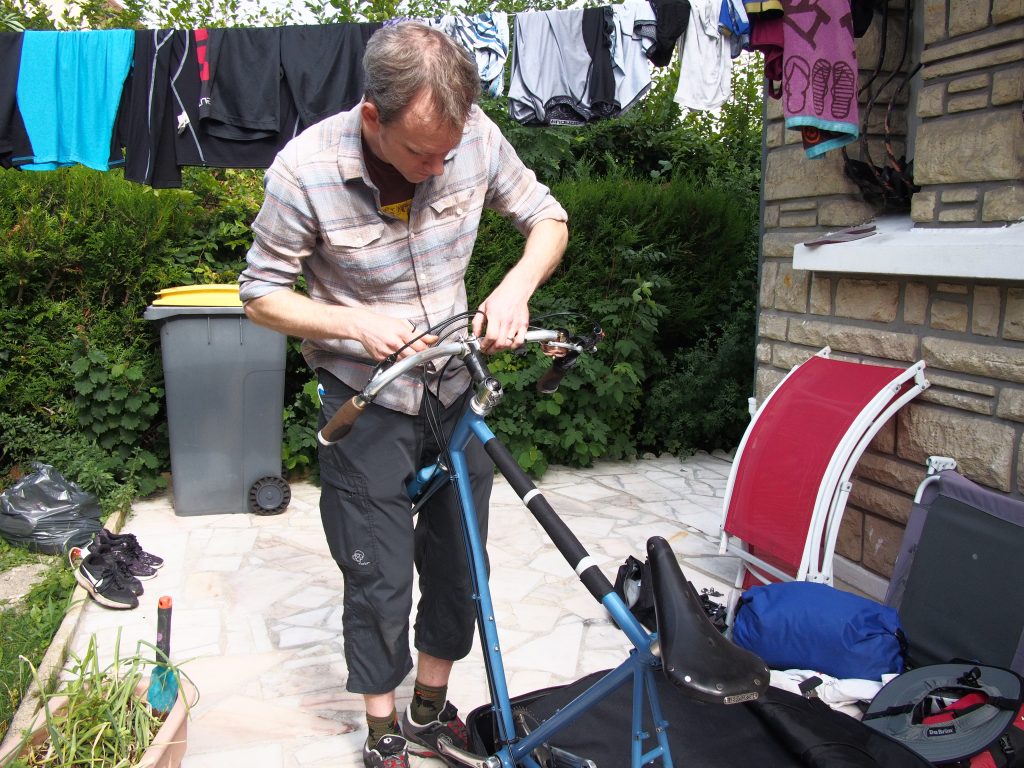
Maurice should have expected to be inconvenienced; he was an Airbnb host. I had told him that I wanted to stay with him at the end of my trip, but at the beginning I wanted to leave a bike bag with him. What I hadn’t told him was that it would take me a couple of hours to assemble the bike. Maybe he inferred this from the fact that he was picking me up with a bike bag with a bike in it, and I was storing a bike bag at his house. In any event, he set me up in his backyard, and introduced the American Putting His Bike Together to his family as they came by throughout the morning: his son, his wife, his nephew, his nephew’s friend . . . he offered me kneepads and coffee, on separate occasions. He took pictures of me assembling the bike with my camera. When my bike was together and my bags loaded, he drove his Land Rover through the streets of Goussainville, the town near the Paris airport where he lived, but on the main streets meant for cars and semi trucks. Jet-lagged and slower than he was, I tried to keep an eye on his Land Cruiser while I pedaled furiously to keep up with him; either because he didn’t know another route or because one didn’t exist, we were going on the “car streets”. He tried to drive as slowly as possible, often pulling over to let cars pass until I caught up. By the time we made it to the train station, I was grateful I hadn’t had to navigate, but also looking forward to an hour on the train, where I was inside something that automobile drivers were scared of. Maurice bid me a fond farewell, almost like I was a nephew, even though we’d only met three hours earlier. “Bon Courage!” he said, the first of many times I would hear that phrase on this trip.
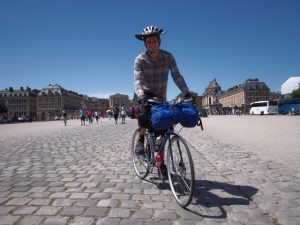
My tour officially started at Versailles, in the sense that I had planned a route starting there and it was mentally my “starting point”. The automobile gamut with Maurice I hadn’t quite expected, because I thought I would be assembling it, a few blocks from the train station, instead of at Maurice’s actual personal residence, which was a few kilometers from the train station. I also hadn’t expected multiple transfers, a long transfer wait, station outages, and re-routing on the RER train that took me across Paris to Versailles. But I made it, and there it was: a giant glittering gilded pleasure palace. I took a few pictures in front of it to add some glamour to the trip, took a spin through the park surrounding it – which was much larger than I expected – and I was off.
A typical bike touring day for me in France is to bike as far as I can, and in late afternoon or early evening, do a search for the nearest campground and make a beeline for it. France is covered with campgrounds, in August usually full of Dutch and English RVs, that will give you a small plot of land and a warm shower for anywhere between three and twenty Euros. The higher-end ones have playgrounds, swimming pools, Wi-Fi, and pool tables. The French word for them is “camping”, which is a noun that means “a tourist campground.”
Rather than winging it for the first day, though, I had researched the closest camping to Versailles, called “Le Camping des Bréviaires”. My goal was just to get out of Paris, so on the second day I could wake up and start riding through the French countryside.
When I arrived, “Le Camping des Bréviaires” seemed a little off. Usually the entrance to a camping is bustling with tourists walking to or from their RVs to a central block of bathrooms, with a clear well-lit reception and often a restaurant, bar, and playground full of children. This one looked worn and un-welcoming, without much in the way of signs. There were blocks of trailer homes, but no recreational vehicles.
The only person visible from the entry gate was a teenager riding a bike that was too small for him. I asked if there was as reception. He said there was, it probably was closed now, but let’s check. We walked in through an open door in a building near the entrance into a dim room with what appeared to be mail cubby-holes covering the wall. The teenager explained something to a woman at the desk that was too fast for me to understand. I explained the situation: bicycle tourist, a very tiny tent, one night.
She thought about it for a moment. “Well, normally a person can’t just stay here for one night, but I suppose if someone invites them to be their guest it is ok.” She looked me over carefully, as if assessing my upstanding-citizen-ness. “I suppose I could invite you to stay, why not, you can stay for one evening as my guest, so long as it does not bother anyone else.” She looked at a very short man in a fedora who I suddenly noticed was also there. “Does it bother you?” she asked. “No, not at all, bike tourist, one night, no problem, he said. “We will have to find a place for you. Follow me,” she said, walking out the door.
I wasn’t sure if I was in the opening scene of the French adaptation of The Shining, or if I should be glad to have found a place to sleep. I had arrived from California on a redeye flight at 730am Paris time and it was now 6pm. I needed to sleep. I followed her out.
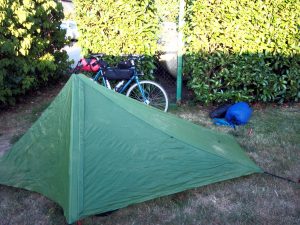
Having determined that it was permissible for me to stay in Camping Les Bréviaires, my host seemed genuinely unsure of where I could actually put a tent. After a bit of walking around, she decided that the only area didn’t belong to anyone specifically was a small strip of grass outside a large propane tank that was surrounded by a fence.
“If I was you I would probably put the bike inside the fence. With the kind of people around here, you never know. Have you eaten dinner?” Because of jet lag and my actual eating schedule that day between bike assembly, navigating the RER, and riding to Camping les Bréviaires, the actual answer to that question was “it’s complicated.” I tried to explain that to her. “Well,” she said, “if you are hungry, we are eating in about a half hour, come by after you set up your tent.” I told her that was very generous of her to offer, and I would come by. What was her name? “Cathy”.
As Cathy was leaving, a small car with racing-style decals on it pulled up and its driver, a guy in his early twenties, said something to me. I didn’t fully understand it, but it seemed to be a joke about accidentally running over my tent during the night. I noticed that the car was actually full: he had three friends in the car with them, but they were all slouched so low it was hard to see they were there. Cathy said something to them that seemed to be, in essence, “get lost.” They drove off.
I set up my tent, and locked my bike inside the area that was fenced in for the propane tank a tight squeeze among overgrown hedge branches and pipes and hoses.
Based on the experience so far, I had no idea what to expect when I went to the area where she lived. I also had no idea who the “we” was with whom I was having dinner. It was unexpectedly normal. “We” was Cathy, her three young-adult children – one of whom was the teenager from the parking lot, who was now doing some kind of repair on his small bike – and a man of about Cathy’s age named Laurent who I took to be her boyfriend. Cathy said it was sardines for dinner, was that ok? I had never eaten sardines in my life, and momentarily thought those were the fish some people put on pizzas before I remembered those were anchovies, but I said ok. I wanted to be a good guest. Maybe picking up some subconscious cue I had given about my feelings about sardines, Cathy said “if you don’t like them, we will have other things.”
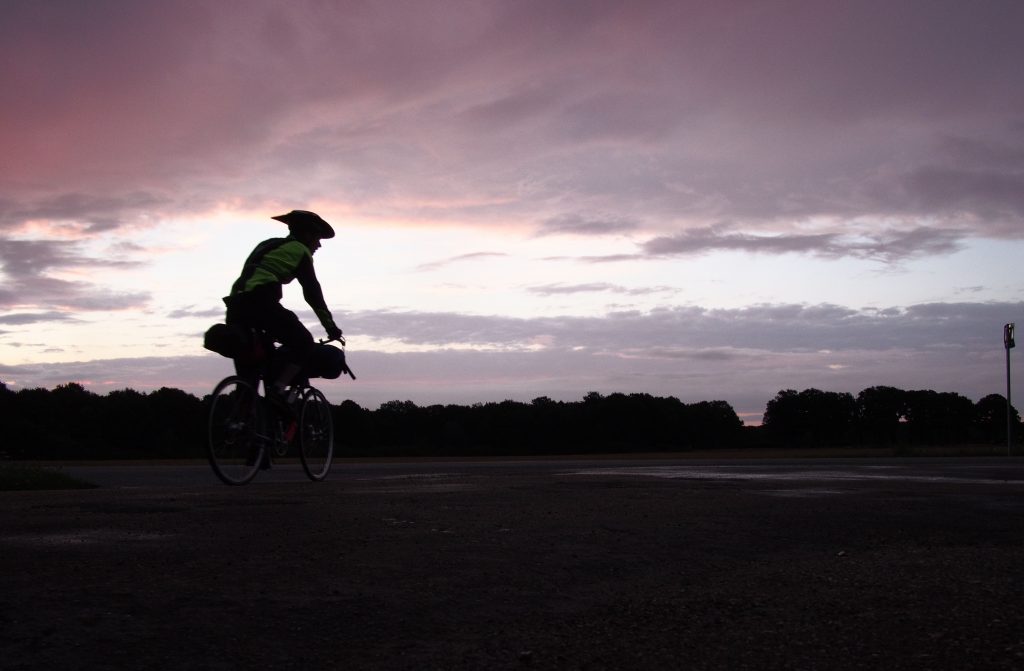
It was an enjoyable dinner. The sardines smelled very strong and fishy as they grilled, but they tasted pretty neutral. Laurent patiently showed me how to cut the head off, eat the top layer, and then peel out the spine and bones so that the bottom fillet remained. After eating two to make a demonstration, I ate some of the salad and pasta. I asked if I was in Normandy yet. I wasn’t. A teenager was sent to fetch the Petit LaRousse, the French dictionary-and-miniature-encylopedia, and Laurent gave me a quick lesson on the difference between a region (large) and a département (smaller). Normandy was recently consolidated from two regions – Upper Normandy and Lower Normandy – into one large administrative region, and I wasn’t in it. It was another 100 kilometers of pedaling. After dining and chatting for the minimal amount of time I deemed socially acceptable, I pled exhaustion and jet lag, and went to bed.
I fell asleep, wondering whether I would be run over during the night. I woke up at dawn due to jet lag, pleasantly un-flattened, and left Les Bréviaires.
Day Two, July 22: the Forêt de Rambouillet. The second day was blessedly boring. The geography of Normandy split the trip up into three natural phases: forests in the south, beaches in the north, then riverside along the Seine to return to Paris.
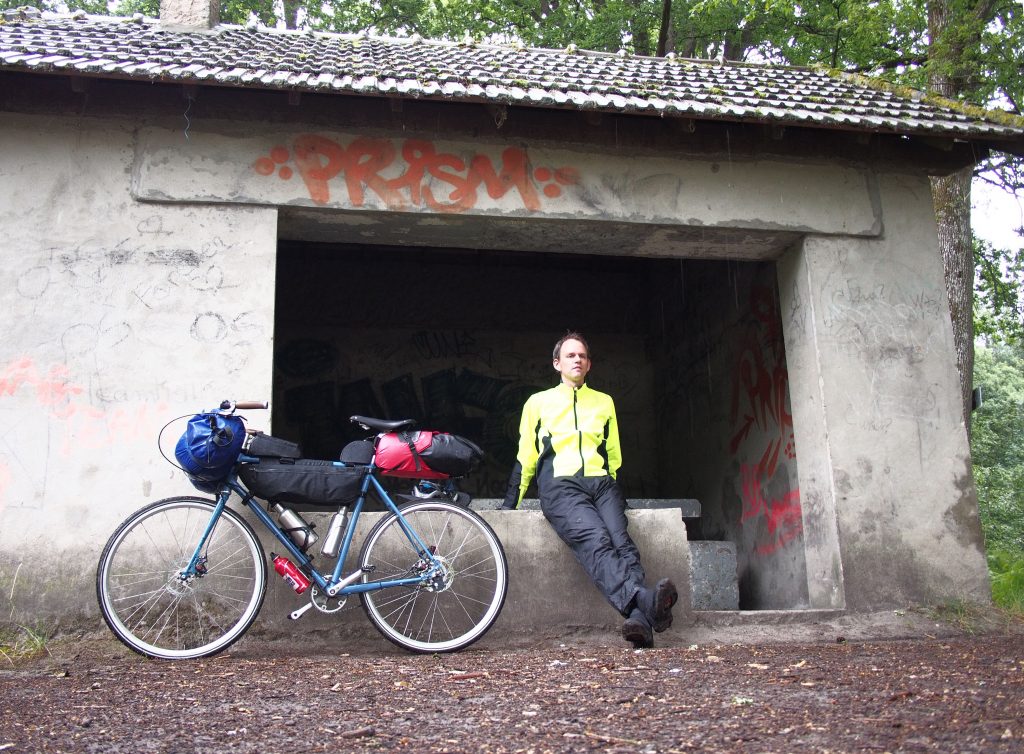
This was phase one as I imagined it would be: riding through the first of several “forêts domaniales” or national forests, the Forêt de Rambouillet, which was flat, paved, and almost entirely car-free. There was a bit of a drizzle, but nothing that would really get me damp. That evening I stayed in a normal camping, paid my ten euros for a hot shower and a camping pitch, underneath some large trees that made a whooshing white noise in the wind. I slept for twelve hours, dreamless and unworried.
Day Three, July 23: Broken Spokes, and Jean-Philippe and Agnès.
Day three started with the French breakfast of champions, called “deux croissants et un petit cafe”, and then was uneventful until lunch. At which point my bicycle made a noise:
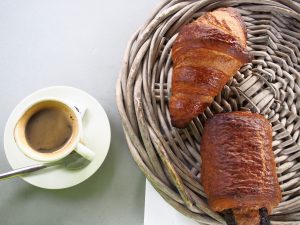
TING!
I was sitting at a picnic table, eating a sandwich. I was not expecting my bicycle to say “TING!”. I went looking for anything that was out of place, and I found a broken spoke. I had never heard of a wheel breaking a spoke while sitting still, but here mine had just done it.
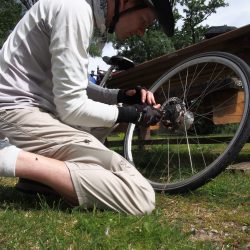
There was nothing else to do but replace it, and check the rest of the spokes. While I was working, another solo tourist, Christophe, rolled up on his recumbent. We compared notes from other tours, and about how we did better alone than on group tours. “Je suis un touriste autonome!” he declared (“I am an autonomous tourist!”), which I thought was an appropriate word for it. We talked about how it was predicted to rain in the early evening, and then he moved on so he could get to his next stop before then. I finished up work, plucking the spoke like a guitar string to try to match the tension with the others, and put the wheel back together and on the bike, and kept rolling.
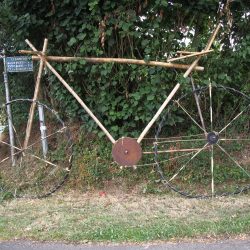
At intersections, I started to see bicycles. Not bicycles for riding, but bicycles ready for a party: usually painted bright colors, or covered in paper flowers, or with a doll or other creature seated riding it. “This region sure likes bicycles,” I thought. Then I came across a seven-foot-tall model of a bicycle made from bamboo and irrigation tubing. Two men were chatting nearby outside of a house. I asked what was up with all the bicycles. They explained that it was a national week of bike tourism in this département next week. Ten thousand bike tourists were expected to descent on the area. Wasn’t I one of them? I expressed my regret – which was real, had I known about this I might have reversed the direction of my tour – but no, I was just a guy who decided to bike here on a random week. One of them showed me the routes in his newspaper that he happened to be holding. It was a national event, in a different region every year, to highlight its biking potential, the Semaine fédérale internationale de cyclotourisme. I thanked them for getting me up to speed.
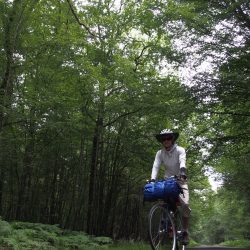
That afternoon I rode through more forests: the Parc Régional du Perche, and the Forêt Domaniale de Bellême. Perche is a historical regional of France that is no longer a political territory and the name exists mostly on the park. Belleme was a town that gave its name to the surrounding forests.
All the forests had a similar feel: they were large, but it was always possible to sense the presence of forestry professionals at work. Trees were spread out, obviously culled to be a minimum distance from each other, and usually leaving an open feeling to the forest floor, the sort of place where you could imagine Hansel and Gretel wandering through. Every ten kilometers or so there would be a gigantic pile of lumber from cut trees. Occasionally there would be a few acres of forest seemed to have
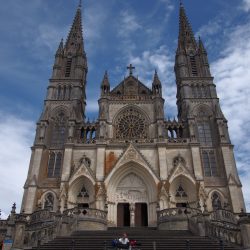
been clear-cut and then re-planted systematically, the trees points on a grid. Ferns were everywhere, gigantic ones that grew six feet tall like hedgerows along the side of the road, and scattered in the forest understory. The roads were all ones that would be white on a Michelin map: narrow, low speed limit, low traffic. Perfect for biking. I passed by Basilique Notre-Dame de Montligeon, a gigantic cathedral-like church built in the middle of nowhere by the Catholic Church around the turn of the twentieth century for a charismatic priest who drew enormous crowds to hear his preaching.
In late afternoon, a few kilometers past yet another bike-festival-bedecked village, it started to drizzle, and then slightly more than drizzle. I had experienced this before in Ireland and Brittany, which have a similar maritime climate: the raingear-ambiguous level of precipitation. Without raingear and you are pleasantly cool and unencumbered, but if it rains more and more, you can end up completely soaked and shivering. With raingear, and you tend to overheat, and it might stop raining in five minutes in which case you’ve spent five or ten minutes stopped, putting on and taking off raingear. Based on the precipitation, I put it on.
And then it happened again. TING! Drive side this time. An easier fix . . . if I had a spoke. I only brought one spare. Well, I certainly wasn’t staying where I was, which was on a moderately busy road with wheat fields on either side. I was pretty sure that in the distant past I had read that you can ride a short distance missing one spoke. Onward, at least to the next hotel or campground so I could deal with it in the morning; it was now Saturday at 6pm and for sure not a single bike shop in France was open now. I stopped a spandex-clad bicyclist going the other way, and asked where the nearest bike shops were. He gave me the names of three towns. If I had to hitchhike, at least I could try to hitchhike to somewhere where there would be spokes.
It started raining harder. Not a storm, but unambiguous keep-your-raingear-on precipitation. The bike started feeling funny. I looked down; my rear wheel was distinctly out of true and was causing a wobble that felt like being on a train. So much for riding with a missing spoke. I stopped, thought for a moment, and started walking back towards town.
I had passed a “Gites de France” sign about a kilometer before that. At the time all that I could recall was that a “gite” was some kind of place that tourists stay, kind of like a bed and breakfast maybe? The sign was about a kilometer back, and since I was walking past it on the way to town, I decided to ask for help there, or at the very least if I could just camp there for the night to get out of the rain and to be settled someplace before dark. The gite itself was about another half-kilometer down a dirt road; I set my bike down halfway and walked the rest without it. The gite was a beautiful, fully-restored farmhouse with a large outbuilding. There were three shiny cars parked outside, and large glass windows with a view into a beautiful common room. I knocked on two doors. No response. Whatever this place was, it was surely booked up. In retrospect, over the rest of the trip, I learned that this was not so much like a bed and breakfast as just a rental house (a “Gite de Hote” is more like a bed and breakfast. This was just a plain “gite” with no host). Probably it was filled with wealthy English tourists who were out at dinner, and did not want their vacation interrupted by a drenched man with a broken bicycle. In any event, there was no one here to help me. I left.
Walking back to the main road, I encountered a middle-aged farmer and his wife driving an old pickup truck. I waved them down. “Is that your gite there?” I asked. It wasn’t. “Ok, thank you.” They looked mildly confused and concerned, but drove on.
“That was really dumb, Joe,” I said to myself. “Why didn’t you ask them for help? An American bicyclist might have been the most interesting thing to happen to that couple this year. Suzanne wouldn’t have just said ‘Ok, thank you.’ She would have charmingly and assertively asked for help. The bike would be in the back of their pickup, and we’d be on our way to drinking warm tea in their farmhouse.” My wife Suzanne had skipped this tour to be home with our eighteen-month-old daughter, so she was not there to be charming and assertive for me. But I did have her voice in my head reminding me that I shouldn’t worry about inconveniencing other people. “I am going to talk to other people. This is a point where I need help. I will be ok with inconveniencing people,” I said to myself. When things get rough, sometimes I have to give myself a pep talk. This was one of those times.
I walked the three kilometers back into town. Hadn’t I seen a sign for a hotel in this village? The plan had been to camp every night, but this was definitely an extenuating circumstance warranting a hotel. The first people I saw were a couple getting out of their car and walking to their house, which had one of the bike-festival painted bikes over the doorway. The woman walked in the door to get out of the rain. The man looked my way with a slightly concerned look – the look of a bicyclist who knows that when someone is walking a bike in the rain, there’s a problem.
“Excuse me, is there a hotel in town?” I asked. There wasn’t. I explained the situation briefly. Broken spokes, need a bike shop. “Is there somewhere I can camp for the night, so I can deal with this in the morning?” Of course there was! In his garden.
His name was Jean-Philippe. The building Jean-Philippe lived in could have been called townhouses or row houses, if the layout was not so byzantine. It was several large residences smooshed together into an interlocking but spacious warren of walls and passageways. He led me under an arched entryway, through a courtyard-and-parking area, through a low dark passageway and then opened a wooden gate into a garden surrounded by a wall. I could stay here. The only condition was that I had to make sure to keep the gate closed, because the hen stayed here at night and he didn’t want her to get out.
I asked him about bike shops. He listed the various bike shops in the area. I asked him how my bicycle and I might get to one of the towns that had those bike shops. Jean-Philippe thought about that. He wasn’t really sure, but he could probably find someone who could drive me, or worst case he could drive me himself. Part of the problem was that it was Saturday evening and French bike shops are typically closed on Sundays and Mondays, so even if I got there, I’d be sitting still for two days. Maybe, he had a friend nearby who might have some extra spokes that would be the right size, and that way there would be no driving at all. The friend was a real bike nerd, had ridden Paris-Brest-Paris multiple times.
We were getting rained on. I was still in full rain gear, but Jean-Philippe was just holding his cotton jacket over his head and he was starting to get wet. He told me to follow him, heading towards his house. It wasn’t really clear what we were going to do there – call his friend maybe? I followed. When we got there, he asked me to take off my shoes and put on some slippers in the entry hallway. Was he inviting me into the house? Should I take off my raingear so it wasn’t dripping all over the floors in the house? Probably best, yes.
Jean-Philippe introduced me to his wife Agnès. Her name is pronounced ANN-yayhs in French, so it took me a moment to realize that it was a name I already knew in English. Agnès offered me tea. His children Rose and Mathis showed up and sat at the table, as well as another man whom I think was family also. It was clear the house was probably two centuries old from the appearance of the heavy wooden beams in the ceiling.
Jean-Philippe and I kept talking about the wheel, and he came to the conclusion that what I needed wasn’t a bike shop, it was a spoke. How long was my spoke? I had the lengths of all my spokes in notes I kept with me: this one was 266 millimeters. “Let me look at my old wheels,” said Jean-Philippe, taking a measuring tape off a sideboard and dashing upstairs. Several minutes later he bounced back down, with a radially-laced front wheel in his hand. The measurement was close but it was impossible to tell exactly while the spokes were in the wheel. Jean-Philippe was completely ok taking it out but wasn’t quite sure how to do it. Did we have to take the tire off? I assured him we did not; I did this once already this morning. I got my spoke wrench and took a spoke off; it was 270mm. A little long, but it seemed better than any of the other options. Did they mind I set to work to see if I can get this to fit? Not at all . . . and Agnès told me that dinner was in an hour and there was absolutely no way I was staying in the garden in the rain when they had a dry bedroom. “Are you sure?” I asked. “I don’t want to inconvenience you too much.” She assured me it was not an inconvenience.
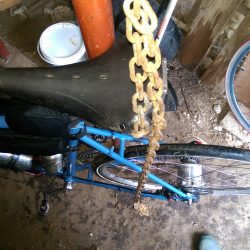
Jean-Philippe showed me a work room, full of bicycles and a lawn mower that made it smell of gasoline. It had a workbench which had only one power tool, and it was the one I really needed: a grinding wheel. After grinding a few millimeters off the end of a spoke, I laced it in to the rim and tightened it. The two bad things I was concerned about – the spoke being too long and poking the inner tube, or not having enough threading to tighten properly – did not happen. This might actually work. Jean-Philippe gave me a chain so I could haul the rear wheel off the ground, and I set to truing the wobble out of it. Since the only theory I could come up with for the breaking spokes was excessive tension, I also de-tensioned all the spokes somewhat. I ground several more spokes down to the right length as spares.
It was dinnertime. Salad, a variety of Norman cheeses, French bread. Agnès made crepes, served with raspberry jam and rhubarb preserves from their garden. Over the course of dinner, I learned that Jean-Philippe had rescued the hen, who as a runaway from a nearby large farming operation; the dog, who someone else had abandoned; and last week he had rescued two young tourists from the Czech Republic who were hitchhiking and got dropped off in his town. Visiting the bathroom, I noticed that the Universal Declaration of Human Rights was posted on the wall. I asked him about it. “It’s for the children to learn.” I had studied the Declaration in law school, in a course on International Human Rights Law, but it had never previously occurred to me that it was something I might post in my house. It doesn’t have anything about rescuing bicyclists in it, but I couldn’t help but think that it was all part of the same philosophical package of helping others when they need it.
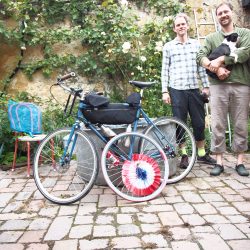
After a hot shower, a solid night of sleep in a real bed, and breakfast with Jean-Philipp and Agnès, I got ready to head off in the morning. Europeans really like seeing people off. I had learned this from my wife’s family, who are Danish and German. They will walk you to the front door, stand where they can see the street where you are departing from, and watch you drive or ride away until you are no longer visible. Normally this is endearing, but when you are on a vehicle you just repaired yourself and that you fear will break again after two hundred meters, it is nerve-wracking. Jean-Philippe and Agnès were no exception to this practice: they walked me out to the street and stood, waving the whole time, as I pedaled away.
It didn’t break. The new spoke and I made it out of sight. For the rest of the day, the words of the Dread Pirate Roberts, from the move The Princess Bride echoed in my head: “Good night, Westley. Good work. Sleep well. I’ll most likely kill you in the morning.” My wheel said every night: “Good night, Joe. Nice riding. Sleep well. I’ll most likely break another three spokes in the morning”. The Dread Pirate Roberts never does kill Westley, and in fact Westley assumes the role of Dread Pirate Roberts so the old one could retire. And so it was with the new spoke: it never broke, and it just became the new spoke that traveled with me. It made it to Mont Saint-Michel, to Utah Beach, back to Paris, and as I write it is sitting in my garage, still laced to the wheel, in Oakland, California. I’m thinking about mounting it on the wall of the garage next to a copy of The Universal Declaration of Human Rights.
Day Four, July 24: Forêt Domaniale de Bellême.
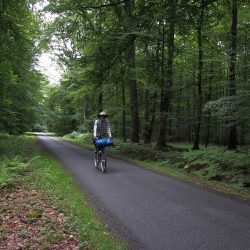
The broken spoke incident was still in the middle of phase one of the trip: the forests of southern Normandy. Unlike Americans, the French do not allow camping in their forests. For me this was difficult to understand: how can you appreciate a forest if you don’t fall asleep there, listen to its sounds at night, and get to unzip your tent in the morning to a view of mists, trees, and forests? Their main method of enjoying the forests seemed to be to drive there early in the morning and go for a walk.
In the Forêt Domaniale de Bellême I came across a French forester. His helmet was on, and he was standing by a car, hatchback open with a chainsaw in it. Since we were the only two people for kilometers around, I said “Bonjour!”. He said “Bonjour!” back, with a hint of a smile, like he was fascinated that someone was biking alone, here. I stopped. We talked for a few minutes about French politics, and American politics, and then I asked him about the camping thing. Why not? It seemed like such a waste of a forest.
“Well, the thing is, if it was allowed, everyone would do it. People bring their beer and make fires, and then we have a forest fire we have to contain. We had one a few kilometers from here earlier in the year where that happened. If you want to do it, you can’t ask!”
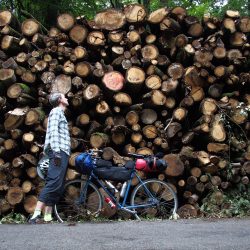
That wasn’t exactly permission, but it wasn’t a compelling case to not stay in the woods either. Start no fires, leave no trace, be gone in ten hours, where’s the harm in that? That evening I was riding through yet another forest, this time called the “Forêt de Perseigne”. The road I was on had been barricaded, with a sign that no motor vehicles were allowed. It was the ultimate bike path, open only to bikes, forestry vehicles, and hikers. I started to look for places where I could pitch a tent. One side path was lined with grass stalks with ticks at their tips, waiting with outstretched claws for a passing deer, hiker, or bike tourist. I turned around, tucking my pants into my socks. Another patch of forest had trees marked to be cut down. Perhaps that would be tomorrow? I moved on. Another patch looked good but was between two roads. Another patch was one of those very regular grids of trees: inviting, but a tent would show up easily. Then there was a field with a hare running across it. I followed it in, and found a spot that wasn’t visible from the road, didn’t have a lot of grass or any ticks I could see. The tent went up.
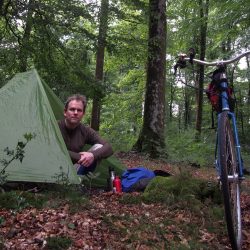
In another difference from American national forests, I had cell service. I called my wife, who I hadn’t talked to in a couple of days.
“You’re talking really quietly, can you speak up?” she said.
“I’m rogue camping in a French Forest! It’s not the sort of thing where you speak up while you’re doing it. Maybe there’s some forestry guy nearby, or a wolf,” I replied.
“Ooooh, right, rogue camping. Ok, I’ll just listen more carefully,” she said.
While touring in France I normally always keep bread, meat, cheese, and cookies or snacks with me at all times. Although France seems like a well-developed, food-obsessed nation, it’s quite possible to go for fifty kilometers or more without a place that sells food. The Sunday closure of the majority of businesses can also leave a bike tourist hungry; what I had forgotten was how many shops also closed on Monday also, especially bakeries which are often the only place to get food in small villages.
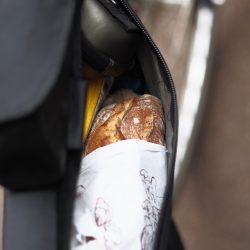
When my wife and I were on a honeymoon cycling around France, we bought a large multi-pack of peanut M&Ms and hid them throughout our bags, so that we could get them if we needed them, but so we wouldn’t eat them all right away. Because this was day three of the tour, I hadn’t yet gotten around to this precaution. And it was Monday night, in a less-populated area of France. My baguette budgeting on Saturday had been inadequate, and I had finished my bread earlier in the day. So now all I had was a dry sausage, called “saucisson”, and a wedge of brie cheese. It was the very best saucisson (from Provence) and the very best Brie (from Meaux), but still was radically incomplete without bread. After one bite I decided that Brie was simply inedible alone. I ate a dinner of straight saucisson. I tried not to think about what my wife would say, since she is always concerned that I don’t weigh enough: “JoJo! You’re going to waste away on a bike tour if that’s all you eat!”
The forest turned out to be surprisingly noisy. Falling asleep I heard a dog barking, which was at first annoying and then concerning. Would I wake up at 2am staring at a hunting dog out my tent mesh? I consulted the mapping application on my phone. There were what looked like farm buildings, but they had to be at least a kilometer away, and this sounded closer. It stopped. I fell asleep.
In the middle of the night there were enormous hooting sounds that had to be from Eurasian Eagle-Owls, and a harsher sound that I guessed was a juvenile. At one point they were very close, I imagined them sitting on a branch just above my tent. I had seen one at a festival once. The Eurasian Eagle-Owl is extremely large, that kind that engenders a “birds come in that size?” reaction. Their hoots were close to classic owl “hoo-hoo”, but more voluminous.
Day Five, July 25: Lots More Forests. The next morning I woke up, happy to have successfully slept through the night in a French national forest, and to have heard enormous birds hooting nearby. As I set to striking my tent and packing my bags, I heard the barking dog again. It was very close. Another one, closer. I started to mentally prepare for what I would say when a farmer (or a forestry worker) and his dog came bursting into my glen with its bicycle, pile of bags, and halfway-standing tent.
It was a deer. A barking deer, bounding through the forest, not fifty meters away. After looking it up later I learned that it was a roe deer, which bark when startled.
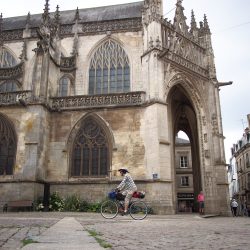
After a very unsatisfactory breakfast consisting of saucisson, and only saucisson, I headed off. A few stops at wild blackberry bushes provided a little bit of extra nutrition (“What would Suzanne say if she knew I was eating roadside berries because I was actually very hungry?”) until I finally made it to the small city of Alençon, found a bakery, and inhaled a wide variety of baked goods. I also checked three bicycle shops in Alençon for spokes. One did not have any in the right length, one was on vacation, and the third had a note in the window that it was closed that day, with no further explanation. With another silent “thank you” to Jean-Philippe, I continued on.
The rest of that day and the next it was forests, forests, and more forests. Blackberries provided roadside treats and a reason to take a rest every ten kilometers or so. In late afternoon I stopped at a campground in
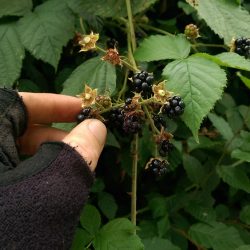
the town of Carrouges, which like many French towns had set up a municipal campground for tourists. Carrouges had taken the unusual step of combining it with their sports complex, since both required open fields and showers. The only other people there were a family of four from the Netherlands. A sign said someone was supposed to come by and collect an eight euro fee for the campsite, but they never did.
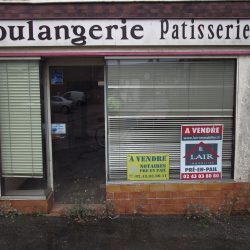
Passing through many of the small towns, I had begun to wonder how many of the houses were occupied, since they often all seemed shuttered. Agnès had mentioned that it was a problem in their village, that all the young people left for the cities, and the houses started to all be empty; although now some of the young people were getting disillusioned and starting to move back. In Carrouges, it became evident that not everyone was gone, because of its pizza truck. The only open restaurant in Carrouges was a kebab shop, but a meat sandwich was not really what I wanted. Then I came to its small central plaza, which was a ring of shops that were all closed at that hour . . . but which had a pizza truck at one end, the only sign of life, which filled the square with the smell of rising bread. I placed my order with the two young men running it, and sat down on a nearby bench. People of all ages started showing up for pizzas: middle-aged women, old men, young parents with three children. Apparently the villages weren’t dead after all, they were just inside lurking, or away working, and waiting for the smell of pizzas to waft through their windows in the evening.
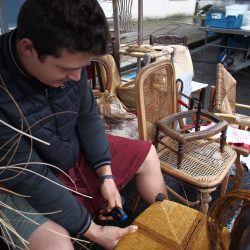
The next morning the same Carrouges square was unrecognizable, since it was market day: eggs, cheese, greens, and other trucks and carts were on display.
Day Six, July 26: Joining The Véloscénie. The next day was . . . more forests. I had arranged this leg of the trip to be all forests, because I wanted to see a lot of trees and ferns, and to be on routes with very little automobile traffic, which is typically the case for forest roads in France. The route had provided all that. After three days, though, I was looking forward to some variation. Six-foot tall ferns can only entertain a person for so long.
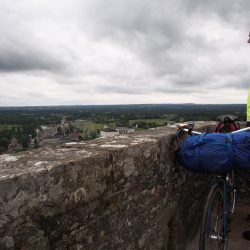
Domfront was that break in the pattern. On the map, it looked like just another medium-sized town, but on arrival it was apparent from tourist-directed signs that Domfront thought of itself as a historically Viking town. Its main feature was a large castle ruin and gardens, which overlooked a precipitous slope into the Varenne river below. The castle walls provided a commanding, almost aerial view of the valley floor below. It was easy to imagine a medieval Norman leader looking around and saying, “We’ll build the castle here.”
By now it was getting to be early evening, but with dusk occurring at ten-thirty at night, daylight was not much of a constraint. Feeling strong, recovered from jet lag, and wanting to make up for my broken-spoke related delays, I pushed on to the town of Mortain, which was the end of the Norman forests.
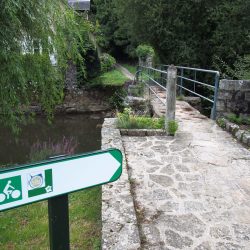
In Domfront I began to follow a signposted route called the “Véloscénie”, which went from Paris to Mont-Saint Michel. This far I had wanted to follow a more remote route, but at this point it seemed worth joining it. At this particular point, it followed a rails-to-trails greenway (“voie verte”), graded almost completely flat and paved with finely ground stone. It was fast: my speed over it was almost as fast as on a road, but without any stops, turns, or questions about navigation. At one point I tried to cut corners by taking another side road that appeared to be shorter and seemed to cross the greenway again after a kilometer. Which it did . . . but twenty meters over it, on a bridge. After retracing my route back to where I had left it, I stopped questioning the Véloscénie’s routing and just followed the signs.
The campground at Mortain was another municipal campground, run by the town. For whatever reason – perhaps the proximity to Mont Saint-Michel, or the coast, or Domfront – this one was fairly crowded. A city employee did come around to collect money: three euros and thirty-two cents for a single person with a tent. This was my sixth night in France and so far I had spent about fourteen euros on accommodations.
Day Seven, July 27: Mont Saint-Michel, Finally. The next morning I met another person named Laurent, this one a solo bicyclist with the tiniest tent I had ever seen, who had also stayed at the Mortain campground. Like many French bike tourists, he did not look like he had spent too much money on gear; he was riding an ordinary mountain bike with a rear set of panniers and a backpack. He had brought a stove to make coffee, though, from freeze-dried crystals. I hadn’t brought a stove or even a cup, on the theory that this was France: food and coffee were not that hard to come by. While we were packing up his things, he made us both coffee, which I drank out of a very tiny glass that he had brought: a shotglass, essentially, although Laurent did not seem like a drinker. At first his manner seemed odd and perhaps almost overly-friendly: the offer for coffee came about thirty seconds after the initial “bonjour”. After a few minutes, though, I realized he was just dorky, earnest, and (like me) had probably spent a little too much time alone in the saddle recently and was eager to talk to another bike tourist.
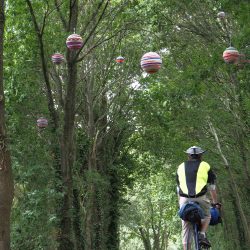
After the coffee and a farewell to Laurent, I kept following the trailway-greenway, and the distance went by quickly. The villages here no longer looked like they were struggling; they frequently had a sign coming into town indicating “village fleuri” status, a national contest for flowery-ness and greenspace planning. Several villages had pavilions with picnic tables, apparently constructed specifically for bicyclists. One pair of villages had decorated a section of greenway with various public-art knitting projects: large knitted insects in the trees, like characters from an entomological children’s book; then large knit-covered spheres suspended from the trees, Christmas ornaments in July. I started to run into more bicycle tourists: a family of four, with a two-year-old and a seven-year-old; a pair of middle-aged women from Lyon who were cycling London-to-Paris, and who extolled to me the virtues of youth hostels and Warmshowers, which they pronounced with maximal Frenchness, “WahmShow-aihres”, as if it had been coined by Voltaire centuries ago.
The bay came into view, along with a trailside sign entitled “The bay, finally!” (“La Baie, enfin!”). It was an appropriate sentiment. The forest phase of this tour had ended the previous day; the waterside phase had officially begun.
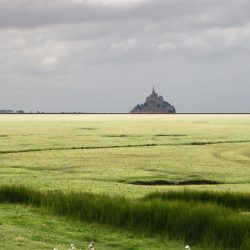
The way into Mont Saint-Michel is pretty bad. There is no safe and direct path for bicycles. I came across a signpost with two signs: a typical car directional sign which pointed one way and said “Mont Saint-Michel 9km,” and a Véloscénie sign pointing the other way and saying “Mont Saint-Michel 17km.”
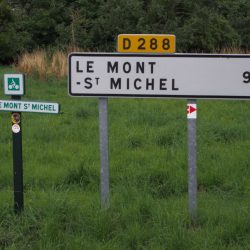
Breaking with my earlier choice to defer to the Véloscénie, I forged my own route again. This was more of a wash than last time: it was shorter, but there were certainly more cars. Perhaps ten kilometers from my destination, the monastery of Mont Saint-Michel appeared on the horizon. Because the surrounding land is so flat, it really stands out from a distance. But then it disappears behind buildings and slopes, reappearing again slightly larger after another kilometer, haunting the road like an ever-enlarging ghost.
In the town of Beauvoir, a few kilometers from Mont Saint-Michel, I stopped in early afternoon and pitched a tent at the campground there. Five years ago I stayed at this same campground, but coming the other direction from Bretagne when my wife and I were on our honeymoon. It was an odd mental sensation: to re-arrive at somewhere familiar, but far away from home, and years after the last visit. This was a fancier campground than any others I had visited, a private one that was more expensive at sixteen euros. It had a bar, and a pool, and a playground for children. I was the only person in the tent-only area. There was a camping trailer at one end of it that seemed incongruously dingy as compared to the rest of the campsite, which included many pre-fab cabins that tourists rented out.
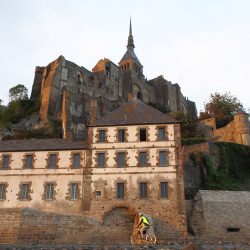
The famous monastery is on an island and surrounded by a village, which is now connected by a causeway. Bikes are only allowed on the path after six in the evening. After dinner at a nearby restaurant, I biked out to Mont Saint-Michel. There were still many tourists, but mostly streaming outward. I could see some professional photographers walking out into the mud flats to get the best possible angle for sunset. I walked past the outer walls with my bicycle, but pretty soon it was apparent that there was nothing to lock a bicycle to, and walking with a bike against a stream of tourists was going to be difficult. Having seen the upper battlements and interior on the last visit, I turned back and settled for taking pictures from the exterior.
Returning to the campground, I found the world’s tiniest tent set up near mine: Laurent had found the same campground. We compared notes on our day riding to Mont Saint-Michel before retiring. With the help of an eyemask, I finally fell asleep before dusk.
I woke up to the thud of someone jumping a fence to enter the camping area, and then talking in a loud voice.
“Yeah, man, come over. No, she’s coming. She’s definitely coming. She doesn’t have a car so it will be fifteen minutes but she will be here. It will be fun. Ok, great. Bye.”
It was three in the morning. Relative silence ensued, with the occasional bang or thump. I dozed back off, only to be awakened again in ten minutes by a flurry of voices. Unzipping my tent, I could see that the dingy trailer was opened up and lit up. I counted the voices: the phone speaker, a woman, and one other man. Music was blaring. It was a party.
“That is way too much noise, this is a campground for sleeping please stop,” I called, in my clearest projected theater voice. There was no chance they did not hear it. Often people are just in another place and unaware that they are disturbing others. Not these guys.
I waited five minutes, cogitating. It was hard to think while halfway asleep. Through past nights of bad sleep I had learned that it was best to deal with the situation quickly, because it’s not going to resolve itself. I got up out of my tent and essentially said the same thing again, directly through the open window of the trailer. Nothing. There was a momentary pause and then they kept talking to each other about something else as if nothing had happened. Was I crazy? The music was loud, but I was not speaking quietly either. I considered rapping on the opened window, but retreated to my tent instead. In the past when I had confronted obnoxious campers it was in my own country, and someone else was with me who would back me up (or run for backup) if it turned ugly. Confronting three shamelessly obnoxious people alone in the middle of the night was beyond my abilities. The party eventually disbanded around quarter after five.
Day Eight, July 28: Over The Hills, Towards the Beaches. The next morning, as I was striking my tent and packing my things, the campground receptionist came and pounded on the door of the party trailer. She spoke too quickly for me to catch every word, but apparently Party Boy was supposed to be somewhere. It sounded like he was supposed to do some task for the campground, but it was unclear what. Muffled sounds of grumpy, sleepy acknowledgement came from within.
“There was quite a party there last night,” I told her, in a voice that I again hoped would carry into the trailer. I really need nine hours of sleep, and I have a vindictive streak.
“A party?” she repeated back with an incredulous look.
“Yeah, from three until five thirty. He had several friends over. Loud music and talking like it was noon. I couldn’t sleep the whole time, or for a while afterward.”
“Sorry,” she said. Her look was of deep, genuine dejection that made me think that this was possibly a relative or someone she was otherwise responsible for. She walked away.
Laurent came out of his tent a few minutes later. We also discussed the party, Laurent speaking in hush tones, me still speaking of my outrage in my clearest theater-projection voice, facing the trailer.
A few minutes after that, Party Boy emerged. Maybe about eighteen or twenty, he was eighteen inches shorter than me and just as thin. If I had seen him in daylight first, I would not have hesitated to pound on his door. A significantly older woman in fishnets and high heels followed him out. They both walked between Laurent and me.
“Bonjour,” he said.
“Bonjour,” said Laurent.
I glared with silent hostility as they walked past.
Party Boy helped Fishnets over the wall of the campground, which was concrete and about five feet high. This was an awkward procedure. At first he tried to boost her by making a step with his hands. It wasn’t good enough for someone in a miniskirt and high heels. He walked and fetched a lawn chair, which got her over.
After another coffee from Laurent (“don’t worry, they come in big packages, I brought way too many,” he said), I was off towards the north, heading towards the beaches where American GIs landed in 1944. Laurent was continuing west into Bretagne, so that was the end of the free campground coffee.
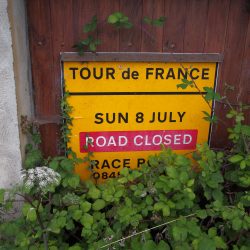
Despite the topography and the fogginess of lack of sleep, I was determined to make as much distance as possible. Rain was predicted to start around four or five pm, and possibly continue throughout the whole next day, and I wanted to try to stay approximately on schedule, to complete the route I had planned.
After two days of signposted route that was mostly greenway, this was a more difficult day. The land had been flat throughout the forests, but today it shifted into shallow rolling hills. It occurred to me halfway through the morning since Mont Saint-Michel was at sea level, there really was nowhere to go but up. The scenery was now typical French farmland. There were seas of wheat and corn like the American Midwest, but broken up with more patches of trees, pastures with cows or horses, or dotted with haybales.
In early evening, about 6 pm, I came to a small village called Gouvets with a farm-style restaurant. This is actually fairly rare: most small villages, if they have a restaurant at all, will only have a kebab shop. Typically I felt best knowing where I was going to sleep, and then finding something to eat, because biking around in the dark looking for somewhere to sleep is risky and unpleasant. I could see a green field with a public bathroom adjacent to it, a hundred meters away. It seemed like it might be a passable place to pitch a tent if it got dark while I was dining.
There were two men inside the restaurant: one at the bar, one seated at a table by the entrance. I introduced myself, asked if they were serving dinner (yes indeed), and then explained the situation. If, after eating, I thought I just couldn’t bike anymore, would it be possible to camp in that field by the bathroom? They conferred and decided that it seemed unlikely that anyone would have a problem with that, so long as I left in the morning. The seated man was named Claude and was super friendly; he said the restaurant was popular with “cow workers” who would all be coming in around seven or eight when they were done with work. Sadly, Claude was only there for takeout, and left shortly thereafter.
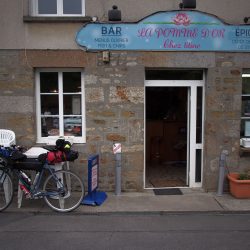
The bartender, who was also part of a husband-and-wife ownership team, took my order for the prix-fixe menu and a glass of cider. How did I want the steak? I remembered that “à point” was supposed to mean moderately cooked, and I wanted medium-rare, so I ordered “a little less than à point”. After taking my order, he plopped a partly-consumed liter bottle of cider on the table with a glass: a serve-yourself system apparently.
This was the meal where I learned that “à point” does not mean “medium”. It means perhaps “medium rare” but it’s really rarer than that. So “a little less than medium rare” is really rare. Like we just singed it for a minute and here you go. The owner, perhaps aware of this, mentioned as he was placing it, that if I wanted it cooked a bit more I could let him know. After a few bites, I let him know. For the rest of the trip I went with à point and was not disappointed; it’s called “the point” for a reason.
Other guests trickled in; several tables of four, and one of about eight older citizens of Gouvets. I began to realize that I was in what was essentially the bar or “waiting-for-food-to-go” section, so unfortunately they were too far away to talk to. The service was surprisingly quick for a French sit-down meal, and even with dessert I was finished within an hour. With daylight until 10pm, there was plenty of time to continue on to a proper campground with a shower. That morning when I had last checked the weather, there was a prediction for heavy thundershowers the next day, so it would be better to be in an actual campground.
As I was outside with my bike, getting ready to leave, a well-dressed man came out to talk to me. After the usual questions (“Are you on a bike tour?” “Where are you going?”), he asked me where I was headed that night. I told him the name of a nearby town that showed as having a campground on the map. “You can go there, but I want to let you know my town, Tessy-sur-Vire, has a very small, quiet campground. Very calm, right next to the river. We drove by coming here and there was only one tent there.”
I thanked him, thought about it, looked at the map, and decided to follow his advice. Tessy-sur-Vire was more on my way, also.
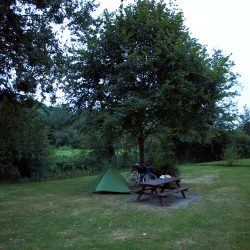
And it was the most perfect little campground: a field of grass with a few trees next to a river, with one shower, one sink, and two toilets. A sign said that it was free as a courtesy of the town, there was a one-week limit, and a docent stopped by every day to check on it. There was only one other couple staying there, who were in the process of building a fire. The man was bald and shirtless, in a Yul Brynner “The King and I” kind of way. I said hello, which they reciprocated. Then I explained my gratitude to be in such a quiet place, especially after I slept so poorly last night in a touristy Mont Saint-Michel campground. They nodded and looked at me like, “good for you.” I pitched a tent on the other side of the campground from them, took a hot shower, and slept like a rock.
Day Nine, July 29: The River Vire and The Beach
It did not rain that night. The next morning the weather report no longer indicated rain at all.
As I started out, I was pleasantly surprised by another feature Tessy-sur-Vire: it was the start of another greenway, which followed the Vire river north to the sea. This greenway was based on a towpath, originally used for draft animals to pull barges up the river. Often towpaths can be boring, because they are typically along canals, and go arrow-straight. This one followed the natural path of the river, and so it curved and meandered, but always slightly downhill. The wind was also at my back. With cycling , the amount of effort is the same, but the resulting speed is often different. On the Vire towpath, the speed was fast, and R.E.M.’s “I am, I am, I am Superman, and I can do anything” started playing in my mind. Most of the morning the landscape flew past at exhilarating speeds. I was going so fast and having so much fun I took zero pictures for the entire morning.
Normandy is best known in the English-speaking world for invasions: first and outbound invasion by the Normans in 1066 into England, and then an inbound invasion by Americans, Britons, and other allied forces during D-Day in 1944. Before I left, I was curious about what it meant to be Norman to the people who actually live in Normandy. Surely they didn’t just identify as the people who lived in the “invasion place”, did they?
When I had asked Jean-Philippe and Agnès and their children what it meant to be Norman, they spoke more of agriculture. For Jean-Philippe, it meant small farms that grew a mixture of crops, with apples and pears being the most “Normande”, and had cattle of the Normande breed, which was a traditional cow of the region that was more rare than it had been in the past. Both pointed to the Percheron, a large white draft horse breed from the region; Agnès later left a book about the Percheron by my bedside. They spoke of the agricultural changes that came with the arrival of Americans in the 1950s. In particular, French farmers were in awe of the power of the American tractor, which led to the plowing under of a lot of the small farms for large fields of grain crops that could have been anywhere. Their son said he felt French first and Norman second. Agnès did say, in a note of hope, that there were significant numbers of young professionals who grew up in the region, got a good education, and were coming back to the smaller towns and villages after getting disillusions with “city work”, and some of them were starting businesses meant to bring back Norman culture, but with a knowledge of modern business practices.
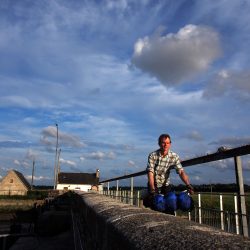
Heading north from Mont Saint-Michel, it became increasingly apparent that, at least in monuments, the effects of the Second World War still loomed large. In the small city of Saint-Lô, an enormous placard was carved into the rock overlooking a major intersection as a monument to those who died in the American bombardment of the city that almost totally destroyed it in 1944. I frequently came across “Voie de la Liberte 1944” bollards, demarcating the path of Allied forces. Most frequent were museum-style educational placards. It seemed like every bridge in northern Normandy had a sign documenting how it was crossed, assaulted, blown up or nearly blown up in 1944. A small canal lock, inaccessible by car, had a full-color sign describing how it was the site of a fierce battle on D-day to control the flooding of the nearby lowlands.
I was now following a signposted route that was the combined route of Eurovelo 4 and “Tour de Manche,” the latter taking its name from the French term for the English Channel. Not long after Saint-Lô, in the town of Saint-Fromond, it parted ways with the Vire River, my scenic, always-slightly-downhill companion that morning. On the map, the Vire’s solid blue line came apart into a hundred blue rivulets in a large wetland. On the ground, the signs stopped and it was hard to tell how to continue. At first, I just found a path that continued by the Vire, but it was grassy and kept getting wilder and wilder and harder to ride through. Eventually I turned back. l asked a passing man and boy, apparently a grandfather and grandson, if they knew how the bike route continued to Carentan, the next large town on my route. The grandfather confidently led me and his grandson back the way I had come, along the river, unfazed by the trail conditions. Eventually we came upon a man fishing in the river, and the grandfather asked him whether this would go all the way to Carentan, and the fisherman said it would. It was now a canal, he said, but the canal went all the way to Carentan. How easy it would be to bicycle, he didn’t know. The grandfather, content that he had shown me the way, bid me farewell and headed off in a different direction.
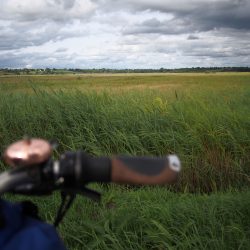
I continued riding for about 500 m when it became apparent that this was not going to be a very good trail to go all the way to Carentan. I turned around, talked to the fisherman for another little bit about on-road routes that I could take, and continued navigating on streets. Shortly thereafter I came across signs for the Véloroute du Parc des Marais. It was not a véloroute that I had been aware of before, but my luck following signs have been good so far. It eventually took me through various wetlands north of Saint-Lô, on gravel paths bordered by reedy plants for almost as far as the eye can see. Although I did not realize it at the time, it was following a small river called the Taute.
The Véloroute du Parc des Marais ended rather abruptly at a busy intersection in Carentan. I barely had enough time to be able to register the transfer from countryside to cityscape when I noticed that there was a pizza truck across the intersection. Everything else was pretty shuttered and industrial, so it seemed a little out of place, but on the other hand there was a lot of traffic going by. I made my way across, and up to the counter. There was one young woman inside who took my order: a pizza with a bunch of toppings including an egg, and a Heineken. An older woman was also in the truck, but shortly after I arrived she exited the truck, and walked around front with a comfortable retirement chair and sat down. I also sat down, at one of the less-comfortable chairs next to the café tables. I said hello as I was sipping my Heineken, and she asked me about where I had been biking that day. Her name was Marie, and soon I learned that she was the mother of the owner of the pizza truck. It was a very new business, and this was its first weekend in operation. Marie had come here to cheer her daughter on as she started her business. She also became a rather engaging storyteller: I asked her about whether Normandy was just an (invasion place), and whether the culture of the area was still affected by the second world war.
“Of course it is becoming less so all the time,” she said. “But, I was born before the end of the war and I remember my parents being employed in the cleanup afterward. For several years after the war, both of my parents were employed to clean up the effects of the war around the shoreline. During the war, I know that my father was sent to Germany, and she and my mother spent the war separated because of that.” She thought it was safe to say that World War II was still a strong part of what it meant to be Norman, especially near the coast. I was somewhat surprised to hear that: I had expected the prominence of Normandy in American’s mind to be simply because so many of them had visited there during the war. What I hadn’t considered, though, is how much the war actually affected everyone who lived in Normandy at the time. The Americans that came here saw at most three months of combat; civilians in Normandy lived through four years of war and occupation. Marie very emphatically encourage me to go and visit Pointe du Hoc, and outcropping that featured prominently in Operation Overlord.
It had now been a long day, and I look for the nearest campsite. There is one that was directly next to Utah Beach, but that seemed like it would be excessively touristy and possibly expensive. I picked the next furthest, Camping La Baie Des Veys. I expected to start seeing Americans in the campground, given the proximity to their history, but the license plates predominantly said “Netherlands” as usual. I paid €22, the highest amount I probably ever paid for a campground in Europe. It was also a remarkable campsite in that no toilet paper was provided in the stalls – if you forgot to bring yours, you could buy some in the gift shop. I couldn’t help but think back to little Tessy-sur-Vire that had provided hot water, toilet paper, and a campsite all for free.
Day Ten, July 30: Utah Beach. This was a fairly uneventful day: I went and looked at Utah Beach, like an ordinary tourist. This was one of the two occasions that perhaps justified bringing a U-lock on the trip. I locked up my bike outside the Utah Beach Museum, and carried all of my bags into the museum to look around. As a bike tourist, with the most interesting items was a German military bicycle, complete with a gun rack along the top two to carry a standard bolt-action rifle. Later in the year, I read about how the Allies had been quite successful in shutting down Germany’s access to oil, so with that perspective a military bicycle made more sense. Outside the museum, there was an actual Higgins Boat, the tiny boats that you always see American soldiers getting off of on the shore in the movies. They are terrifyingly small in a way that film did not convey: 36 feet long (the size of a medium-sailboat) and intended to carry 36 men.
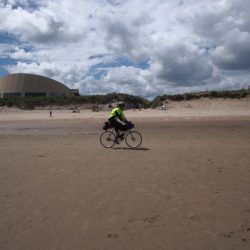
I talked to one man on the beach from Lithuania; after he took a picture of me cycling on the beach, I asked him what brought him there. He said he came almost every year, because he was drawn by all the history.
From Utah Beach, I headed through some rather unremarkable cycling until I reached Isigny-sur-Mer. I made a stop in Isigny because there is a brand of butter, and a type of cheese, that I taught at my local grocery store in California that is from there. Unfortunately, the town itself is rather unremarkable except for a café on the main street that had a sign saying “Welcome And Thank You To Our Liberators” with Canadian, American, and British flags underneath. I thought that was a bit much, especially since it’s almost 80 years later. But now at least I know where that butter and cheese come from when I buy it.
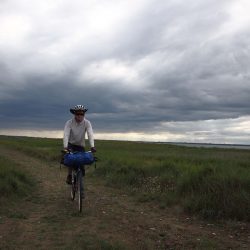
After Isigny I got back on Eurovelo 4, which ran along the shore of the English Channel (“la Manche” in French), scrub grass on my right, a short beach and open ocean on the left. It was a lot more effort to pedal off-road, but I also appreciated the solitude and natural beauty. I was surprised that something that was designated as a route to bike across Europe was so rough, but I guess the Eurovelo system is comprised of whatever routes are available, and sometimes they’re not very developed. After about 25 km of offroading, a frontage road started along the shore. I reached it just as the clouds coming in over the Channel started to produce a spitting: more than a drizzle, less than a proper rain. Because I was close to where I was planning to camp, and because putting on (and possibly taking off) rain gear was just another delay, I kept going.
My campsite for the evening was at “Camping du Fort Sampson”. Like almost all of the campsites, I found them using OSMAnd, the OpenStreetMap mobile application. Sometimes I would Google them in advance – if it was the only campground for kilometers around, and I didn’t want to get stranded if it wasn’t actually a campsite – but often, like this day, I just showed up to see what was there. It was simple: a big open field, a bathroom building in the middle surrounded by trees, and a trailer near the entrance that served as a welcome building.
French campgrounds are rated on a system of stars: for example, the one that I had stayed at the previous night was €22 because it had a swimming pool, restaurant, and cabins that you could rent. This one had no stars. However, I found the couple who ran it to be extremely friendly and accommodating. They still took orders for a local bakery for pastries I wanted in the morning, and the price was only five euros. I asked the wife more about the star-rating system, and whether they would try to get more stars eventually. She explained that it was about amenities like whether there was a pool and a restaurant, but also about how much of the year the campground is open. The requirements for a campground to have more stars involved in being open more and more of the year. With an “aire du camping” like they operated, they could be open whenever they wanted. So they closed it down between November and February, which they just spent hanging out at their primary residence in Paris. I agree that that sounded like a pretty sweet deal, and I wouldn’t try for more stars either.
Day Eleven, July 31: Point du Hoc (sort of) and Omaha Beach
After a pleasantly unremarkable night in Camping du Fort Sampson, I set off for part two of the Operation Overlord segment of my tour. Per Marie’s recommendation, I was first going to visit Pointe du Hoc, then Omaha Beach, and hope to end up in Bayeux by the evening.
Pointe du Hoc is an elevated promontory on the Norman coastline between Utah and Omaha Beaches. It is visible on a map as a point that sticks out from the coastline. In 1944, it was the site of a German artillery battery, under concrete casemates to protect from aerial bombardment. Accordingly, the Allies felt that the only method available to attack it was to do a special forces attack, climbing up the cliffs from below. The commanding officer of the Army Rangers who is supposed to lead the attack said the night before that he thought it was a “suicidal” mission, and was replaced at the last minute. There were, in fact, quite heavy casualties for Rangers, but they did successfully destroyed the guns at the top. The 1962 movie The Longest Day is made about the attack.
When I arrived at Point du Hoc I was expecting something similar to Utah Beach: maybe some memorials but mostly and open air Park that you could visit the actual site. In fact, it was a rather built up memorial, and there appeared to be a security entrance to part of it. It was not very clear which part was meant to be secure: there was a building where I could see the there were metal detectors, but it seemed like it was maybe an entrance to some separate part, or building that I couldn’t fully see. I went ahead and walked towards what seemed to be the actual natural feature of Point du Hoc, but I was stopped by a French woman in a uniform and told that I would have to leave my bike and bags in the parking lot. I explained that I could lock my bike, but I didn’t have a car trunk or other secure place to leave my bags. If I just set them in the parking lot, I would be afraid that they would be stolen.
“This is not my problem,” she said. “These are the rules: no bicycles, and no large bags.”
“I have come several thousand miles from California to visit the place that is important to people for my country. Is there nowhere that I can leave my bags, I can ride my bicycle several kilometers to leave them somewhere else.”
“I’m sorry,” she said. “I don’t know where you can leave them. There’s not very much around here.”
So I left. It seemed like such a ridiculous rule, but I couldn’t think of any way around it. I suppose I could ask some other people if I can leave something in the trunk of their car, but it’s a seemed too difficult. I looked around the perimeter of the park; there was no barrier, and there was another trail about 300 m away that seem to go to the other side of the promontory. It had a “no bikes” sign, but no attendant. If I hadn’t just been stopped by the security staff, I might have tried it. As it was, I decided to move on.[1]
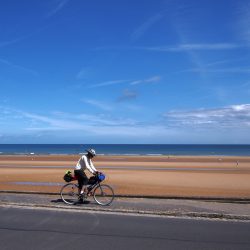
Omaha Beach was even more “just a beach” than Utah Beach. There were signs, and some cafés, but no large museum; just large, expensive, homes that look like they were probably high-end vacation rentals. The people who were on the beach seem to be mostly there just to enjoy it; some were flying kites. It was starkly sparse: almost a kilometer of sand from the road to the water line, nothing but a shallow slope of sand and an enormous expanse of blue sky overhead. I couldn’t help but imagine arriving on one of the little Higgins Boats I had stood in the day prior, with hostile machine guns on the shoreline; it made me feel very small and vulnerable. Having read All The Light We Cannot See recently also made me sympathetic to the idea of being a teenage boy in 1940s Germany, swept into the Nazi machine; I don’t most boys at that age has been able to sense of moral agency to be able to consider what they are doing, anymore than American boys in the 1970s had a considered sense of why they were fighting in Vietnam.
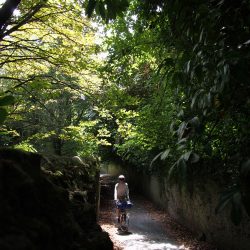
In the early afternoon I made my way from Omaha Beach towards Bayeux. This is mostly flat, ordinary agricultural land, with some occasional forested sections. The main memorable part of this afternoon was that I was getting really tired. I didn’t want to fully admit it, but I had been biking every single day now for almost 10 days. I was very motivated to complete the loop that I had planned out, biking down the Seine to Paris, but I also had to recognize some fundamental physiological limitations. The typical advice for bike touring is to take a day off every week. When I was bike touring with Suzanne, she enforced that strictly. I was a little bit more zealous in trying to bike until I dropped, but I was now finding that I was dropping off.
I got to Bayeux around two in the afternoon, and for the first time on this trip I went and found a hotel instead of a campsite, so I could really completely rest. I checked in, and as is often the case they wanted to store my bicycle in a garage. While I’m separated by my bike that it will be stolen; one comfort of camping is that your bicycle is always five feet from you. Bayeux is a minor tourist destination, mostly with history buffs who want to visit the historical tapestry that documents the Norman invasion of England. I joined the tourists where the tapestry is displayed in a dedicated museum building.
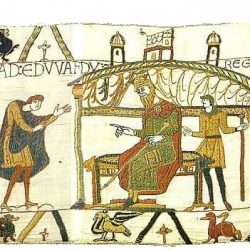
The tapestry is 230 feet long; in order to create a coherent viewing experience, the museum is audio tour only. Everyone gets an audio tour and walk along the tapestry as explained to you what’s going on. What was most surprising about the tapestry is how expressive it was. The stitching is done in a way that looks for all the world like a modern day cartoon. The characters are expressive, and even the border is used creatively: initially it is abstract decorative creatures, but when the battle of Hastings is shown the order is transformed into jumble of dead bodies. The authors did not shy away from demonstrating the cruelty and in humanness of warfare.
One of the difficulties with biking in France is that the food is very delicious and as a calorie-burning bike tourist you want to eat a lot of it; but it often takes a couple of hours to eat a proper meal in France, which is not so much fun by yourself. So in many cases I had been eating pizza, crepes, doner kebabs and other faster-foods because I just wanted to fall asleep after it had reached a campground in evening, or because that was all that was available in the particular village.
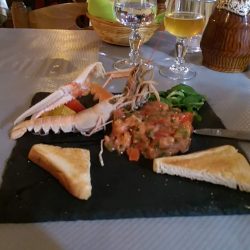
When I finished looking at the tapestry though it was 4 PM, so I found a Norman restaurant in Bayeux had a multi-course meal: prawns (memorably served with their claws stuck into their abdomens), cheeses, hanger steak (ordered à point, having learned my lesson; sublimely pan-fried, caramelized-crispy on the outside, rare inside), a “trou normand” (“Norman hole”) which is calvados served mid-meal, and ice cream. Normally I don’t mind eating alone, but on the French multi-course meal schedule – designed for social eating – it was something of a Buddhist exercise. I essentially had to meditate in between courses while I waited for the next dish to arrive. The food itself was amazing, and I could feel my body soaking up the calories.
After dinner, I stumbled home and went to sleep immediately, the only night I spent in a hotel on the tour.
Day 12, August 1: Bayeux to Equemauville
When I woke up in the hotel in Bayeux I had 150 miles to go to my planned end-point of Giverny, with three days to do it. In my original plan, I had hoped to ride from Giverny into Paris as well, but with the lost time to the broken spoke I had to adjust my endpoint. Fifty miles a day is somewhat ambitious, and it meant no slacking off or taking long breaks to admire the scenery or sit through lengthy multicourse meals. Since I was staying in a hotel, I took full advantage of the breakfast bar, gorging myself on croissants and scrambled eggs before setting off. Because I gone to sleep so early, even though I’ve slept for 11 hours, I was one of the earlier starts I had.
The day was mostly on rural roads that were emblematic of why I love bike touring in France: their only purpose seemed to be for farmers to get to their fields. Despite despite that they mostly appeared to have been paved recently: the tarmac flawless, smooth as the autobahn. Maybe two cars would pass me in an hour.
Because I was trying to make as much distance as possible, I stopped eating at restaurants as much and started stopping at grocery stores and buying ready-to-eat foods. Initially, I felt a little bit like I was doing it wrong: five come all the way to France, wouldn’t I want to eat the best French food? Surely that would not be in the grocery stores. But French grocery stores, even the big ones, have their own charms.
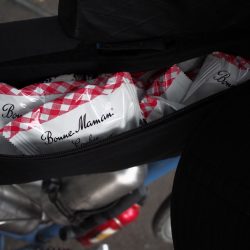
Each cookie aisle was a wonderland of new confections: LU Pims in a wide assortment of fruit flavors (although orange remains my favorite) and Bonne Maman hazelnut chocolate chip cookies were particular standouts. I took to keeping my frame bag stuffed with cookies, eating them while pedaling. I felt especially guilty buying a pre-made chicken salad sandwich at a big-box grocery store, in a triangular plastic container: the type the usually get in a vending machine. To my surprise, it was one of the best sandwiches I had on the trip. I also bought a plastic clamshell of coleslaw, because French restaurants will give you a little bit of vegetables but not a lot. I ate the entire thing in one sitting, more than half a pound of coleslaw; it was that good. Apparently if food is a priority for a culture, the improvement in quality extends to all the food, not just the high-end restaurants.
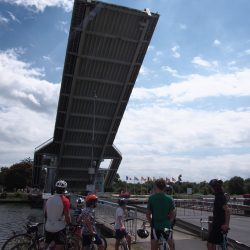
I skimmed past the northern edge of Caen and went over the remarkable Pegasus drawbridge at Bénouville, named after the emblem worn by British airborne forces, who took and held it during Operation Overlord. After an afternoon of biking through more small roads and villages, I halted in late afternoon at five-star campsite in Équemauville, just south of Le Havre. The next day involved crossing a bridge that was allegedly a bit difficult, so I wanted to do that when I was fresh and awake. The campsite, called “La Briquerie”, was in a field in the middle of nowhere, surrounded by agriculture. But it had a covered pool with a waterslide, bouncy houses and playgrounds for little kids, a crêperie and a full restaurant, tennis courts, a soccer field: the works. This is the sort of place the people came to spend the summer with their kids. Giving me think about how I was looking forward to biking with Suzanne and Maeve, because this would be the sort of place that would be very fun for them. As it was, having biked pretty hard day, I ate dinner at the restaurant, set up my tent, and collapsed. I had a surreal experience using the bathroom in the middle of the night; small things were moving about in the shadows, and eventually I realized that the entire campground was filled with rabbits, dozens and dozens of rabbits.
Day 13, August 2: Le Havre and The Beginning of the Seine
This was the least pleasant day of the entire trip. I had read in the guidebooks that Le Havre was an interesting city because it was built more recently, and I also wanted to see the mouth of the Seine. In order to visit Le Havre, it is necessary to cross the Pont de Normandie, a suspension bridge that carries an autoroute, the French equivalent of an interstate highway. Other reports on the internet were “it’s possible, there’s a bike lane, but it is harrowing”.
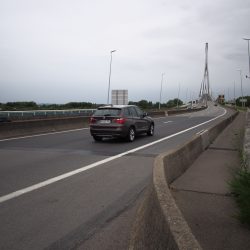
I can now personally verify this. If you are considering this, I would highly encourage you to bike to the ferry at Quillebeuf-sur-Seine and use that to get to the north bank of the Seine instead. The entryway is fine, they built a nice ramp up to the base of the bridge for cyclists . . . but then the bike lane itself was not separated from the autoroute. It was like a bike lane you’d find on a minor street in the United States, but directly adjacent to semi trucks going 60mph. There was, however, a pedestrian walkway that was separated by a concrete barrier from the highway. Being a natural rule-follower, I rode in the designated lane for a few hundred yards. At that point, I remembered that I was a father of a 1-year-old, and had a higher responsibility to bring myself home alive, so I lifted my bike over the barrier and rode the rest of the way on the pedestrian path, which was reasonably safe. There weren’t any pedestrians anyway.
Pont du Normandie is in two segments: one large suspension bridge that is the bridge proper, and then a smaller bridge that goes over the estuary to the north of the river. After crossing the main bridge I assumed I would just continue over the smaller bridge; Google Maps showed a bike path going across. However, the bike/pedestrian ended at a stairwell that descended into a parking lot at the base of the main bridge. After wandering around for a few minutes trying to figure out how to continue, I asked some gendarmes who told me that, yes, it’s forbidden to go over the bridge and I would have to go around. This resulted in a large detour on the appropriately named “Route Industrielle”, a frontage road for semi trailer-trucks with no space designated for bicycles. To their credit, all of the truck drivers were extremely professional and courteous, but there just wasn’t enough space for both of us. The best I can say is that I survived to make it into Le Havre itself, but its industrial core, not the interesting part with modern buildings. That part was off to the west; I needed to head east. Originally I had planned to make a visit into the center of town, but at this point I was pretty emotionally exhausted from dodging vehicles and was eager to be off and the countryside again. I headed east, leaving Le Havre for another trip.
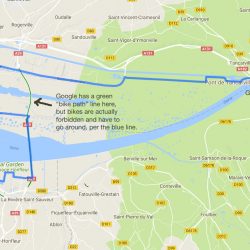
This is now the third phase of the trip: the first had been the forests of the South, the second had been the beaches of the north, and now I was heading inland along “Les Boucles de la Seine”, the “loops” of the river heading inland. The first 15 miles were river-industrial: the bike path along a flood-control canal, past factories and refineries. These eventually faded away, into small riverside roads with tiny towns, too inconvenient to access via autoroute because of the oxbows of the river. Pear and apple orchards became common sights, all seemingly small-scale. On several occasions I saw a lone Frenchman on a ladder in a tree harvesting fruit. By late afternoon I was on yet another tiny, quiet rural road.
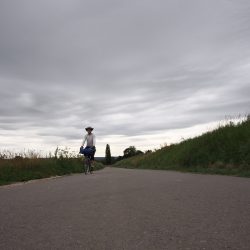
I targeted a campground that was in the middle of the promontory created by an oxbow, hoping to find a quiet, remote place. When I arrived, there was a sign at the entryway saying that the campground is full. By now I knew better than to be deterred: I went into the welcome center, and uttered the magic words to the woman there: “avez-vous place pour une personne, une petite tente, une nuit?” (“ Do you have space for one person, one small tent, one night?”). She gave me the “yeah, probably” face, with a small nod, and told me to wait while she helped some other people. After a couple of minutes, her husband came in and I explained the situation, and he said “well, let’s take a look.” He hopped on his own bike that was outside the welcome center, and we rode around until he found a site that had a cabin with some construction materials next to it. “The people who on this cabin aren’t here, and probably aren’t going to be here this month. You can set up your tent here.” This is a campsite without a lot of stars or swimming pool or anything fancy: it was a place where people came to be out in the countryside and away from people. There is no restaurant, but there were cans of cold beer for sale. I bought one, made myself a sandwich, talk to Suzanne for a few minutes, and as per usual collapsed into deep and dreamless sleep.
Day 14, August 3: Jumièges to Vernon.
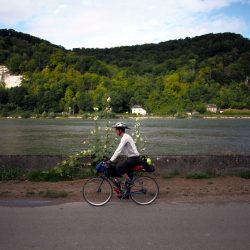
This was the last day. I felt a kind of sadness that the trip was ending, and a desire to soak up and enjoy it as much as possible because this would be the last bike touring by myself for a while. It also was an ambitious day: I still may need to make 60 miles to get to a campsite near Monet’s gardens at Giverny. The distance immediately became longer when a ferry turned to be out of service – at Yville-sur-Seine – that I had been expecting to use to cut off one of the oxbows. Instead I had to bike halfway around it to make it to the next one, at Duclair. Along the side of the Seine, there were frequently paths, probably originally constructed as tow paths. In some cases they been paved, but many of them were gravel. Often there is not a human to be seen, although there was typically a fisherman sitting on the bank every few miles.
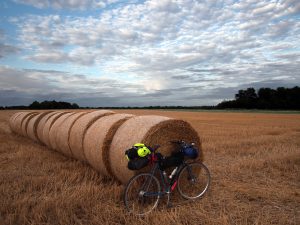
Later in the day, my route diverged from the river, as I stayed South going in a straight line towards Giverny, and it continued to wander in a squiggle to the north. If I had had more time, it would have been worth following all of the squiggles, but at this point my choices were limited by the schedules of the world: I needed to get to a train to get to my plane. There were several small forêt domaniales that echoed the beginning of the trip, but toward the end of the day it became typical French farmland. Bathed in the orange late-afternoon, the fields strongly resembled Monet’s haystacks paintings I had seen repeatedly growing up at the Art Institute of Chicago, although updated with twenty-first century “hay rolls” instead of the nineteenth century pyramids.
The campsite that evening was about five kilometers from Giverny, a very basic affair that appeared to be run by the municipality. The sign outside said it closed at 8pm, and I arrived at 8:45. The welcome was closed; I asked a young Italian couple what to do. They shrugged. An older Polish couple advised me to just camp and pay in the morning. Which is what I did.
Day 15, August 5: Vernon, Giverny, and Back to Paris.
The next morning when I paid, the man working the welcome desk, as part of the usual registration process, asked to see my passport. When I handed mine over he looked up, startled.
“You are American?” he said.
“Yes.”
“We don’t get many of you here.”
“How many in a year?”
“Five or six, maybe. Maybe not even that.”
This seemed surprising since it was so close to a major tourist destination, but Americans did not seem to have camping on their radar for tourism in France.
Having learned my “you can’t take your bags in and there is nowhere you can leave them” lesson from Point du Hoc, I did internet research in advance for Giverny. Apparently the only place anyone knew of to leave bags was a café across from the Vernon train station. Upon arrival, I asked at the bar if this was possible. The bartender was a lean man with a scarf around his neck, who was mute. He first looked me up and down, like he was assessing whether I was a tourist and not a terrorist or a police informer. He wrote the price on a scrap of paper – five euros a bag. I shrugged in assent, since there was really no alternative. He led me through several doors and a hallway to a locked room, where several other bags lay. I paid him, and he locked the door after we left. Overall, it felt more like a drug deal than a valet service. I am still not sure if this was because storing bags for people is illegal (why was there nowhere else in Vernon or Giverny to store bags?), or it was just suspicion about terrorism.
The ride to Giverny was a pleasant three miles on bike paths. Feeling strangely light without my luggage, I flew along and bunny-hopped over curbs. At Giverny I was one of two bikes at the rack in the parking lot. Most tourists visit Giverny as a day trip by train from Paris or somewhere else, so they tend to arrive mid-morning or later. Arriving by bicycle I was one of the earliest arrivals at 9:30 in the morning, and the line to buy tickets was only five minutes long.
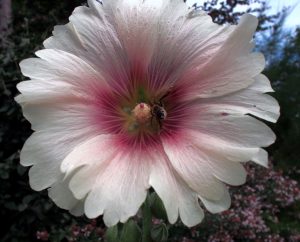
Arriving at major tourist destinations by bicycle is always an unusual experience: for me, the main destination when I go to France is just a small backroads, the tiny bakeries in remote villages, and the food. But for many other visitors to France, it was just destination after destination like Giverny: a nexus of people from all over the world in this highly developed and structured presentation of a specific part of French history. After a week of just being among French people in French countryside, it was a jarring re-entry into modern life.
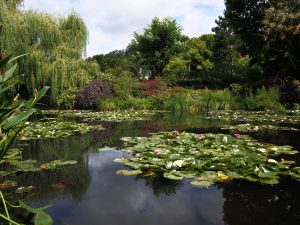
Some of the main tourist destinations I just can’t handle: of the half-dozen times that I have been to Paris, I’ve never been to the top of the Eiffel Tower. It is just too many people, too much hype, too much waiting in line (although after reading about Gustav Eiffel in Frederick Brown’s For The Soul of France, I might persevere next time). For some destinations, the connection to another time and place makes it worthwhile. I grew up looking in Monet’s paintings at the Art Institute of Chicago, and my dad was a big fan of Monet, so I felt some affinity for him. I respect his quiet rebelliousness: the man just wanted to leave the city behind, look at nature and the French countryside, and represent it in his own particular way. As his paintings began to sell mid-life, Monet bought the house and land at Giverny, and then more land, and put time and money into developing the land into a spectacular botanical garden. He then painted the gardens that he had made.
The gardens were remarkable, but mostly in a sense of scale and variety of flowers. My main thought was not so much “wow this is beautiful” but rather “wow, how many people does it take to maintain this place?”. It was row after row of flowers of every possible color and description, packed densely together. It seemed like no plant was done blooming yesterday or ready to bloom tomorrow, they were all timed to flower on the particular day I arrived. A lot of that certainly was seasonal, but there must also have been a small army of horticulturalists working after hours to prune and plant.
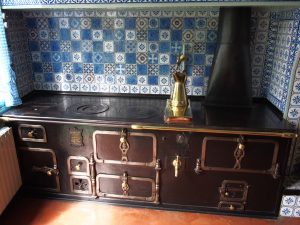
My favorite part was not the flowers, but the kitchen. Not so much that it belonged to Claude Monet, but just as a window into what a high-end kitchen would have looked like at the turn of the twentieth century. The tilework is all blue and white, the stove a monumental block of early art deco iron and brass. The space itself was immense – four people could easily cook together in here without bumping into each other – and flooded with light, from windows looking over the gardens behind it.
And that was pretty much it. I rode back to Vernon, got my bags from the suspicious mute bartender, and got on the next train to Paris, made my way through the metro system and the regional train, and let myself into Maurice’s AirBnB, where I set to disassembling my bike for transport.
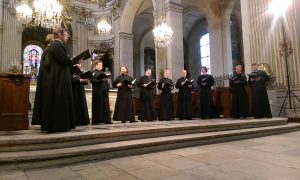
Day 16, August 6: Paris. The next day I had time to wander around Paris. Although Paris is not my favorite part of France, one thing I love about it is that usually, on any given day (but especially if it is a weekend) there is probably a top-tier classical concern happening somewhere, and August 6 did not disappoint. I found a late-afternoon a matinee performance of Russian ecclesiastical music at Saint-Louis-en-l’Île, a small (for Paris) Catholic Church on an island in the Seine; a choir of a dozen men who put on an amazing (and deafening, although it was not amplified) performance. Not the sort of thing I can usually find at home.
When I got back home, it took me a week to re-acclimate and be even approximately in a normal frame of mind. Bike touring is a perpetual flow-state activity: all-day exercise, all-day novelty, with small but simple problems to solve. There is a connection with my body that you don’t get from sitting in an office chair: how much further is it possible to go today? How much food do I need until there probably is another bakery or marché? It also put me out in the tangible world in a way that rarely occurs in everyday urban life, which often seems to revolve around only a few locations. It gives a sense of scale of the world: how far fifty miles is, how many people live there, how land is used by people, and how ecosystems shift over a distance of ten or a hundred miles. In the city, the sun is present, but sunset just means it is time to flip on a light switch. On tour, sunset means you better have found someplace to stay.
After a few months, reflecting on this trip it seems so different from ordinary life that it seems like maybe it was from a different phase of my life rather than last year, or perhaps a dream. However, the Jouhannets – the family that gave me a spoke for my wheel and a place to stay – and I have sent each other cards, and just last week I got a surprise package from France that was some gifts from Normandy from them; and dreams don’t send you gifts in the mail, I suppose.
****************
Note
[1] Six months later I emailed the American Battle Monuments Commission to complain, and they replied “While are policies prohibit riding bikes on this site, there are no restrictions on carrying your personnel bags onto the site. If you wish to enter the Visitor Center, then you will need to pass through our security procedures to include a search of your bags.” Either I didn’t understand something, or the ABMC doesn’t understand what is going on at the site. I suspect it is the latter, since the policies there were consistent with other French high-risk-of-terrorism sites (usually labelled as “Project Vigipirate”), like Giverny later in my trip.
****************
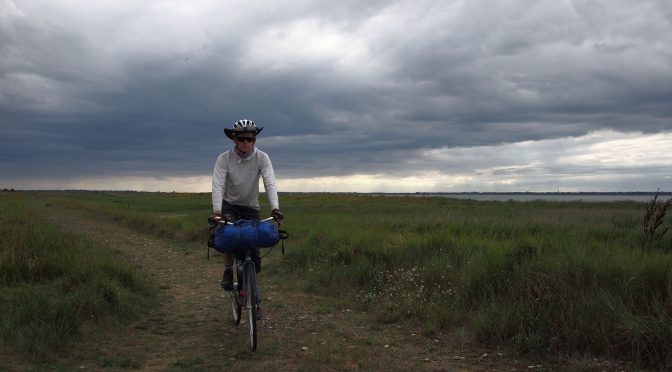
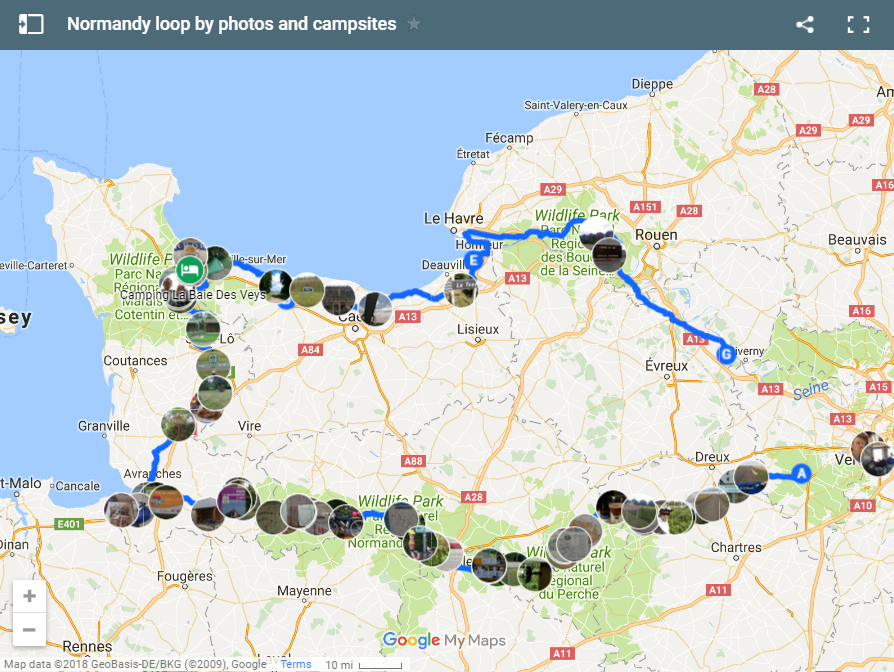

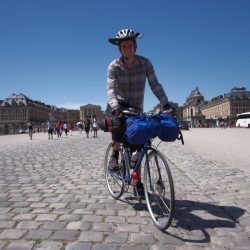
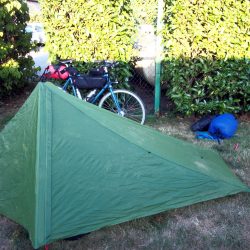
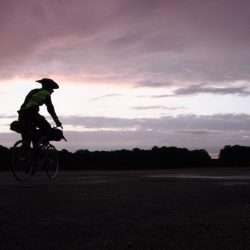
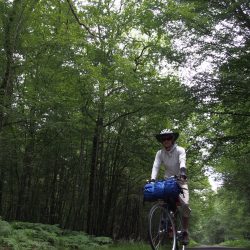
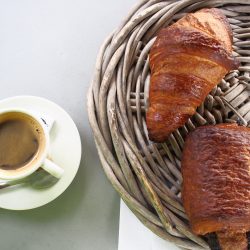
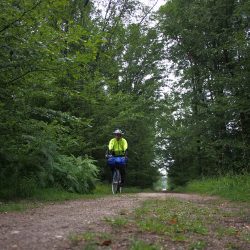
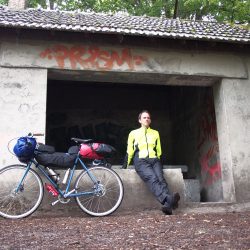
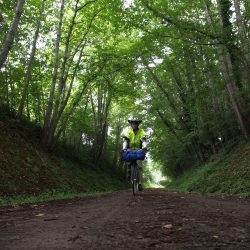
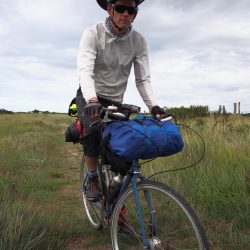
Leave a Reply